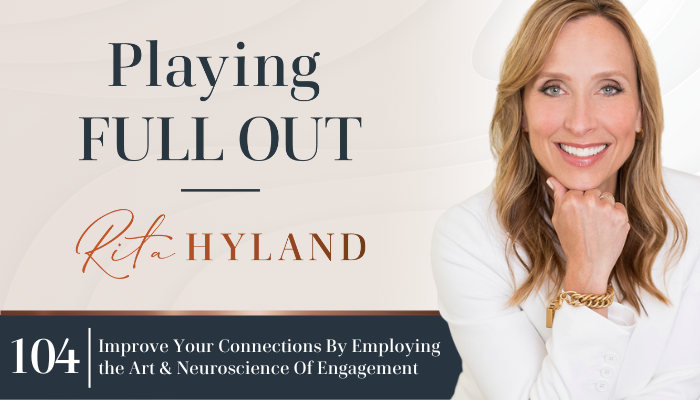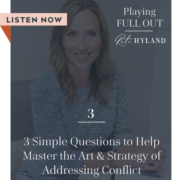Improve Your Connections By Employing the Art and Neuroscience Of Engagement

Listen to the full podcast episode to learn what is needed before every interaction to be successful, what the savviest managers and most effective leaders do, and my simple 4-step S.A.F.E. method that will drastically increase the quality of your engagements and allow others to not only feel safe but truly empowered by you.
Recently, I was training a group of managers in the coaching leadership style, discussing how to have an effective coaching conversation with team members. This particular company understands that the best version of a business comes only when employees are becoming better versions of themselves. The company is creating a culture that reflects that.
At one point in the training, I noticed one of the managers had a smile on his face. I asked him what was so funny? “Well, it’s not that it’s funny,” he said, “but I can’t imagine some of my team wanting to have this conversation with me.”
He was right. It occurred to me that much more was actually needed to be said about the art and science of engagement. After all, if the employee views talking to their manager as risky instead of rewarding (as he was suggesting), then the team member is not going to engage with him. The communication is shut down and he becomes ineffective no matter how talented he is.
And this applies to all of us in ANY interaction.
We want to contribute, to serve, to help, to support, and to influence in business, at home, or in our community, but we can’t do this if we are perceived as more risky than rewarding to engage. We can really want these outcomes, but if the individuals on the other end of our engagements do not feel safe with us, we won’t be able to share our talents, gifts or services with them.
So, how do you get others to engage with us while feeling safe?
One of the most important aspects of getting individuals to talk to you is understanding neuroscience to establish yourself as someone rewarding and safe to engage with.
Here’s a quick peek into how the brain works:
5 times a second, the unconscious mind scans the environment and asks, “Is it safe here?”
If the answer is no, then our mental operation is taken over by the amygdala – the least developed part of our brain whose primary focus is on survival. If it determines that the environment is unsafe, it focuses solely on what it needs to do to survive: fight, freeze (remain quiet), or leave the interaction completely.
Now, when the brain does feel safe, it operates from the prefrontal cortex, at its highest level. It’s capable of navigating nuance, managing ambiguity, and assuming positive intention.
With that quick dive into how the brain works, we can see that how we manage people matters. How we let them know they are safe is absolutely critical.. In order to do so effectively, I’m going to share with you my simple 4-step process called S.A.F.E. that’s going to help you communicate so others feel safe and empowered in their engagements with you.
S.A.F.E.
When the brain feels safe, it can operate at its most sophisticated level. When we feel safe, we are engaged and are capable of progressing forward. If we are unsure of a situation, our subconscious minds will default to reading it as unsafe. Think of it as a barking Chihuahua. If you walk into its home, it has now perceived – something bigger and unknown – as a threat. It does not feel safe and therefore begins to bark incessantly. This is equivalent to the mind that chatters and ruminates. Before you can go any further, you have to make the barking dog feel safe.
In the first step of the process, we address Status.
The brain asks: What is my status in this? Is there a ranking in this interaction? Am I valued in this engagement? Are we equally important?
If the subconscious brain sees itself as lower, it barks incessantly like the chihuahua. Your job in this step is to not set the dog off by threatening its status.
For example, if you’re providing feedback as a manager to a direct report, it’s important to let the individual know this is an interactive process where you’ll be providing feedback and that you see them as equally important to you. Where the brain may be concerned with a difference in status, you want to assure it that although we may have different rankings in the world, you and I are bringing equal value.
In the second step, we address Autonomy.
The brain asks: Do I have a choice?
Not having a choice makes individuals feel walled in. We want those engaging with us to feel that they have choices. We can do this by asking them for ideas or suggestions. As I begin a coaching engagement, I say to the other individual, “I’m going to ask you questions and you get to choose whether you want to take my observations or reflections back or to drop them.” I don’t make the person feel like a prisoner. It’s like a pair of shoes: if they don’t fit, you wouldn’t buy them.
In the third step, we address Friend or Foe.
The brain asks: Are you on my side? Are you with me or against me?
An easy way to do this as a manager is to remind the person that you are on the same team. You can say things like, “We’re on the same team here… What I want for you is…” and then fill in the blank. Use “we” and “us” language instead of “you” language. That way, you ensure people know you are a friend that is on the same team as them.
When I first engage with new clients, I let them know that once I agree to work with them, I become their number one fan. This act calms the subconscious mind.
In the fourth step, we address Expectation.
The brain asks: What’s the future?
Remember that the future is uncertain and the brain sees uncertainty as exceedingly dangerous. If the brain doesn’t know what to expect in an engagement, it’s going to resist. It might fight back. So, be aware in the initial moments of an engagement to clarify what is going to happen. This helps individuals know what to expect, even if it’s just for the next 15 minutes. In doing so, you provide clarity which calms the brain and keeps it from ruminating and interpreting that danger is lurking.
When beginning an engagement, you can say:
“Today, we’re going to…”
“I’m going to ask you this…”
“At the end, we’re going to come full circle and this is what we’re going to make sure we covered…”
Doing so paints a picture that lets others know what to expect by telling them what the future is going to look like.
When you follow this 4-step acronym, you set the foundation for and begin a very healthy and rewarding interaction regardless who it is you are engaging with. While the 4 parts are the same no matter with whom you’re interacting, the order of the steps can be adjusted to flow with your conversation.
This week, I challenge you to make someone feel safe in your next engagement with them. Ensure that they feel valued and equal to you, that they have the autonomy to make certain choices, that you are there for them, and clearly paint a picture of what they can expect in this engagement. Then, sit back and enjoy the connection.
In this episode I share:
- The key thing needed before expecting any successful engaged conversation
- My simple 4-step process (S.A.F.E) to drastically transform and elevate your engagements both in the office and at home
- Specific examples of what you can say to establish instant connection in any interaction
Resources and related episodes:
- If you’d like to be notified of when new podcast episodes are released, you can do so here: Playing Full Out
- Learn more about the Inside Out Method
- Connect with Rita on LinkedIn.
Subscribe on Apple Podcasts for more tips, tools, and inspiration to leading the optimal vision of your life, love, and leadership. Remember, a half version of you is not enough. The world needs the fullest version of you at play.
___
About Rita Hyland
With over 20 years of experience as an executive and leadership coach, Rita helps leaders — emerging and established — excel in corporate and entrepreneurial environments.
Rita believes if leaders were more clear about how transformation really works and more intentional about creating what they want, their impact, success, and influence in the world would be unstoppable.
Through her coaching programs, private coaching, and masterminds, Rita shows leaders how to win consistently and create the impact and legacy they desire.
Central to Rita’s work is the understanding that you will never outperform your current programming, no matter how strong your willpower.
When you learn to use Rita’s proprietary Neuroleadership Growth Code, a technology which uses the best of neuroscience and transformational psychology to hit the brain’s buttons for change, YOU become both the solution and the strategy.
Her mission is to end talented, hard-working, and self-aware leaders spending another day stuck in self-doubt or confusion and not contributing their brilliant work and talent the world so desperately needs.









Leave a Reply
Want to join the discussion?Feel free to contribute!